Survey of Earned Doctorates Field of Study Taxonomy Changes in 2021 and Impact on Trend Data
Disclaimers
Working papers are intended to report exploratory results of research and analysis undertaken by the National Center for Science and Engineering Statistics. Any opinions, findings, conclusions, or recommendations expressed in this working paper do not necessarily reflect the views of the National Science Foundation. This working paper has been released to inform interested parties of ongoing research or activities and to encourage further discussion of the topic.
Abstract
This working paper describes the motivation for changing the Survey of Earned Doctorates (SED) field of study (FOS) taxonomy used for collection and reporting of education data items in the 2021 SED, and the improvements to education data items. The paper also examines the impact of these changes on the distribution of historical FOS data and provides guidance on conducting trend data comparisons.
Introduction
The field of study (FOS) data for research doctorate recipients is a rich and valuable source of information for federal agencies, policymakers, and researchers. Collecting these data is a complex undertaking and requires considerable input from respondents. Innovation to reduce response burden and improve data quality is an important goal for the National Center for Science and Engineering Statistics (NCSES).
To improve data quality, the 2021 SED changed the FOS taxonomy to utilize the detailed fields available in the National Center for Education Statistics 2020 Classification of Instructional Programs (CIP) and changed the education data items used to collect FOS. This working paper summarizes the changes, examines the impact of the change on the SED trend data, and explains how to make comparisons between the new FOS data and historical data.
Changes in the Field of Study Taxonomy and Education Data Collection
This section describes changes to both the SED FOS taxonomy and the educational history data collection and how these changes improved the quality of FOS data.
Prior to 2021, the SED-FOS list, a two-page list in a paper questionnaire comprising 334 fields, was used to classify FOS data for respondents’ doctoral degrees and doctorate dissertation research, as well as their master’s, bachelor’s, and associate’s degrees. The SED-FOS list was reviewed and updated every two years based on a review of the degree fields respondents reported in the SED. This review process identified changes in the doctorate fields and ensured coverage of emerging fields.
Over time, the FOS review process and examination of fields reported as “other” fields, made clear that the 334 fields in the SED-FOS list were not sufficient to accurately capture respondents’ degree fields, particularly associate’s and bachelor’s degrees. Respondents’ FOS verbatim strings and comments also indicated the need for additional detail in the SED-FOS list. Further, the SED-FOS list also did not include multidisciplinary/interdisciplinary fields, which are important emerging fields.
An expansion of SED FOS fields was also needed in order to improve the alignment of SED FOS taxonomy with the NCSES Taxonomy of Disciplines (TOD) to facilitate comparisons of FOS data across NCSES surveys. Because the SED moved to a full Web-based data collection, it is no longer limited by the size constraints imposed by a paper questionnaire, allowing for a longer FOS list.
New CIP-based Field of Study Taxonomy
The 2020 CIP taxonomy includes more than 1,900 fields, providing much finer FOS details than the historical SED-FOS list. However, some doctoral degree fields collected in the historical SED-FOS list, as well as doctoral dissertation research fields, were not included in the 2020 CIP list. Thus, modifications to the 2020 CIP were made to create the SED-CIP list used for the data collection in 2021 (see table A-1):
- Addition of over 50 fields not in the 2020 CIP collected in the SED prior to 2021, to preserve the trend data.
- Exclusion of non-degree CIP fields (CIP 12, 28, 32, 33, 34, 35, 36, 37, and 53 series codes).
- Restriction of CIP 46, 47, 48, and 49 series codes to collection of associate’s and bachelor’s degree FOS only, consistent with Integrated Postsecondary Education Data System (IPEDS) reporting patterns for those fields.
- Creation of new SED-CIP 70 and 71 series for clinical health fields based on the CIP 60 and 61 series health professions and medical residency fields, for collection of dissertation research fields only.
The new SED-CIP taxonomy enables comparisons with historical trend data and will improve visibility into the growth and contraction of the fields over time.
Improvement Efforts in Collection of Education Data Items
The SED education section is divided into Part 1, which collects data on respondents’ doctoral degree and dissertation research, and Part 2, which collects additional data on respondents’ education history, including postsecondary degrees received prior to earning a doctorate. NCSES undertook a methodological study to test alternative methods for collecting respondents’ educational history. Based on findings from the study, the SED made the following two major changes to the 2021 Web instrument:
- The survey used the new detailed SED-CIP list in place of the old SED-FOS list in collection of all FOS data items.
- Respondents were asked to report all postsecondary degrees earned prior to their doctorate, in any order, and then were asked for more information (e.g., institution name, FOS, degree start and awarded dates) for each degree. Prior to 2021, respondents were asked about their associate’s, bachelor’s, and master’s degrees in a specified order.
"Appendix B. Field of Study Items, Selected Screenshots from the Web Instrument: 2020 and 2021" illustrates the changes.
Impact of Field of Study Taxonomy and Education Data Collection Changes in Data Quality
Doctorate recipients reported their FOS with increased frequency and more specificity using the new SED-CIP list than in prior years. The 2021 data collection saw increases in item response, self-coding rates, and reporting of multiple dissertation research fields—indicators of clear improvement in FOS data quality.
Improved FOS Item Response Rates
In 2021, item response rates increased across all FOS data items. For example, the item response rate for FOS of research doctoral degree rose from 97% to 98%, an increase of 1 percentage points (table 1).
Item response rates for doctorate field of study: 2020 and 2021
Source(s):
National Center for Science and Engineering Statistics, Survey of Earned Doctorates.
Improved Respondent FOS Self-Coding Rates
Respondents to the 2021 SED were more likely to find and select the FOS for their degree items from the SED-CIP list available in the Web survey. The overall self-coding rate increased by 5 percentage points, from 92% to 97% (table 2), which resulted in the respondents self-coding over 3,500 more FOS data in 2021 compared with 2020.
Respondent field of study self-coding rates: 2020 and 2021
CIP = Classification of Instructional Programs; FOS = field of study; SED = Survey of Earned Doctorates.
Source(s):
National Center for Science and Engineering Statistics, Survey of Earned Doctorates.
Reduction in FOS Manual Coding Cases
Some respondents provide a FOS verbatim string rather than self-code their FOS to one of the fields in the SED-CIP list. These FOS verbatim strings are assigned a SED-CIP code using a combination of automated and manual coding methods. The FOS verbatim strings are first autocoded and all remaining verbatim strings are then sent for manual coding (see "Appendix C. Field of Study Coding" for more information on the autocoding process). After autocoding in 2021, there were 3,448 FOS verbatim strings that needed manual coding, about half as many as in 2020 (see table C-2 in Appendix C). Reduction in manual coding workload helps to reduce the coding costs.
Improved Reporting of Dissertation Research Fields
In addition to the improvement in FOS degree data quality, a higher number of doctorate recipients reported multiple dissertation research fields in 2021 (table 3). Even though the total number of doctorate recipients declined by almost 3,000 between 2020 and 2021, the number of respondents reporting multidisciplinary/interdisciplinary dissertation research fields increased by 3,981, which represented about 10 percentage point increase from 2020.
Reporting of dissertation research fields: 2020 and 2021
a Number rows show count differences, and percent rows show percentage-point differences.
Source(s):
National Center for Science and Engineering Statistics, Survey of Earned Doctorates.
Using New Field of Study Taxonomy Data
The main goal for the new FOS taxonomy was to enhance the analytic utility of the field classification for data users. Collecting data using the SED-CIP list also allows fields reported in published SED data to better align with the NCSES TOD and fields used in other surveys, such as the IPEDS Completions Survey.
Improved Details in the Field of Study Data Reporting
The historical SED-FOS taxonomy reported data for 8 broad fields, which were further disaggregated to 35 major fields. The new SED-CIP taxonomy contains 16 broad fields and 66 major fields (table A-2). This expansion of broad and major fields provides more detailed and useful FOS data in the published data tables. For example, in 2020, some 23% of doctorate recipients earned degrees in the life sciences broad field. In 2021, the new FOS taxonomy broke life sciences into three broad fields: agricultural sciences and natural resources (2%); biological and biomedical sciences (16%); and health sciences (5%). Other historically combined fields, such and mathematics and computer science were split into the two broad fields of mathematics and statistics, and of computer and information sciences (table 4).
Research doctorate recipients, by new broad, major, and detailed field of doctorate: 2021
CIP = Classification of Instructional Programs; nec = not elsewhere classified; STEM = science, technology, engineering, and mathematics.
a Field level provides information about the fields that are nested together. There are four levels of field aggregation: area, broad field, major field, and detailed field.
Note(s):
Beginning in 2021, a modified version of the 2020 Classification of Instructional Programs (CIP) codes was used in the survey data collection, and the new broad, major, and detailed fields were used in tables reporting only the most recent data year. Therefore, the field of doctorate data in 2021 may not be comparable to prior years. See table A-1 for a full list of SED-CIP codes in the new field taxonomy, table A-2 for a summary of the new SED field of taxonomy, and table A-3 for the SED-CIP code crosswalk to the historical field taxonomy.
Source(s):
National Center for Science and Engineering Statistics, Survey of Earned Doctorates.
A new set of detailed fields also allows for improved field aggregation. In the historical SED-FOS taxonomy, 59 of the 334 fine fields reported in the 2020 published data tables (see 2020 table 13) had fewer than 30 doctorate recipients. The new detailed fields for SED-CIP reporting were created to include at least 50 doctorate recipients (except for the two “not elsewhere classified” fields in atmospheric sciences and meteorology, and in materials and mining engineering; table 4).
For the most part, the new detailed fields in the SED-CIP taxonomy improved granularity for many large fields (table 4). As an example, in the historical SED-FOS taxonomy, computer and information sciences had 4 fine fields (table A-3); in the new SED-CIP taxonomy there are 7, as artificial intelligence, computer systems networking, and informatics and information technology are large enough to be reported separately in their own detailed field groups. However, there are a few fine fields in the historical SED-FOS taxonomy (see 2020 table 13), such as Russian or Japanese language and literature under foreign languages and literature, that no longer meet the new threshold of 50 cases to be included in the new detailed fields. The new SED-CIP codes as well as the historical SED-FOS codes are available under the NCSES Doctorate Records File (DRF) restricted-use file license.
Inclusion of the Multidisciplinary/Interdisciplinary Fields to Track the Field Changes Over Time
Another notable benefit of the new SED-CIP taxonomy is inclusion of multidisciplinary/interdisciplinary sciences as a separate broad field in science and engineering, and multidisciplinary/interdisciplinary studies as a major field in non-science and engineering. Adding these fields to the new SED reporting taxonomy captures the growth of the convergent fields and improves FOS alignment with other surveys.
Using Historical Field of Study Data for Trend Comparisons
This section highlights key changes in the SED data that are likely due to the FOS taxonomy change and describes how to use historical fields for trend data analyses. To facilitate comparison of the 2021 SED-CIP data with prior years’ data, the SED-CIP codes collected in 2021 were assigned to the most appropriate historical SED-FOS codes based on the past FOS autocoding and manual coding rules (see table A-3). This crosswalk allows for trend data comparisons with some limitations as noted in this section. While the cross-walked data allows for trend comparison, the historical SED-FOS data in the 2021 SED should be treated as estimates when compared to the actual counts in 2020 and prior cycles.
Assessing Impact of Taxonomy Change
The impact of the FOS taxonomy change in 2021 is difficult to isolate due to the concurrent impact of the COVID-19 pandemic. The total number of doctorate recipients in the 2020–21 academic year (table 5) declined by 5.4% from previous years. To mitigate the impact of this decline on the trend comparison, the taxonomy change impact was evaluated in percent distributions rather than counts to better compare whether the proportion of doctorate recipients by doctorate field may have been influenced by the collection of FOS data using the new SED-CIP codes rather than the historical SED-FOS codes.
Overall, the share of doctorate recipients at the historical broad and major field levels, along with the relatively small percentage point changes from 2017 through 2021, suggests that trend comparisons at the historical broad and major field levels are quite reasonable (table 5). The percentage of doctorate recipients in 34 of 43 historical broad and major fields changed by 0.3 percentage points or less between 2020 and 2021.
Research doctorate recipients, by historical broad and major field of doctorate: 2017–21
* = value between 0.00 and 0.05.
nec = not elsewhere classified.
a Field level provides information about the fields that are nested together. There are two levels of historical field aggregation shown in this table: broad field and major field.
Note(s):
Due to rounding, percentages may not sum to 100. Beginning in 2021, a modified version of the 2020 Classification of Instructional Programs (CIP) codes was used in the survey data collection; the historical fields were reconstructed using the crosswalk in table A-3. Therefore, the field of doctorate data in 2021 may not be comparable to prior years. See table A-1 for a full list of SED-CIP codes in the new field taxonomy and table A-2 for a summary of the new SED field of taxonomy.
Source(s):
National Center for Science and Engineering Statistics, Survey of Earned Doctorates.
Historical Broad Field Level Comparisons
At the SED historical broad field level, the trends and proportions of doctorate recipients within the life sciences, physical sciences, mathematics and computer sciences, and engineering align well across years. The proportion of doctorate recipients in life sciences has consistently declined from 23.2% in 2018 to 22.6% in 2021. Similarly, the share of doctorate recipients in physical sciences, which declined between 2019 and 2020, continued its decline in 2021. The proportion of doctoral recipients in mathematics and computer science and in engineering has grown every year since 2017.
The growth in psychology and social sciences from 2020 to 2021 is partially explained by the increasing proportion of doctorate recipients in economics and in other social sciences. Humanities and arts showed the largest change, declining by a whole percentage point (-1.0) from 2020 to 2021. While the share of humanities and arts doctorates has declined in each year from 2017 through 2021, the percentage-point decline in 2021 is the largest annual change.
Historical Major Field Level Comparisons
Some of the broad field differences are driven by changes at the major field level. The decline in the proportion of doctorate recipients in foreign languages and literatures may be related to the increase in other social sciences. Specifically, the availability of separate “studies” codes in addition to “languages and literatures” codes in the new SED-CIP list may have allowed respondents to better self-code their fields. Whereas, using the historical SED-FOS list, a respondent would have been only coded to area, ethnic, and cultural studies if they specifically typed that field name. For example, “German”—one of the foreign languages under humanities—was included in the historical SED-FOS list but not “German studies”—one of the area, ethnic, and cultural studies under other social sciences. Therefore, if a respondent with a doctorate in German studies typed “German,” only the foreign language field was available for the respondent to select. In the new SED-CIP list, typing in “German” prompts the respondent to select between all fields that contain the string “German” including German language and literature and German studies. This is true for over 20 sets of SED-CIP codes in these two major fields.
The expansion of the fields within economics from 3 codes in the historical SED-FOS taxonomy (econometrics, environmental/natural resource economics and economics, other) to 9 codes in the new SED-CIP taxonomy (see table A-1) may have contributed to increased proportion of doctorate recipients in economics.
Historical Fine Field Level Comparisons
The SED-CIP code crosswalk to historical fine fields (table A-3) allows data users to estimate the historical fine field level data based on the data collected using SED-CIP code as each code is mapped to a historical SED-FOS code. The proportion of doctorate recipients across the historical fine field estimates shows that the data are generally comparable between 2021 and prior years, although with some cautions. There are no counterfactual data on how the 2021 SED respondents would have self-coded their field using the old SED-FOS list. For example, respondents who self-coded their FOS to electrical engineering and computer science using the SED-CIP list would not have had this choice using the historical SED-FOS list. Respondents using the historical SED-FOS list had to choose between electrical engineering and computer science. This adds an additional level of uncertainty to the historical FOS fine field level estimates.
Conclusions and Recommendations for the SED Field of Study Trend Data Uses
The historical FOS estimates at the broad and major field level (table 5) are generally more comparable than at the fine field level due to larger numbers at the aggregate levels. Given these limitations, only the historical broad and major fields are reported in the published 2021 SED data tables that show multiple years of data. Also, for tables showing only the most recent data year, the 2021 SED data tables use a single level of detailed fields instead of “fine fields” or “subfields” used in the prior year data tables (e.g., tables 13 and 16 in 2020 versus table 3-1 in 2021).
SED restricted-use data users of the DRF will have full access to the field data at the SED-CIP code level as well as the SED-FOS code level data created via crosswalk for all FOS data items—research doctorate, first two doctorate dissertation research fields, and other postsecondary degrees. The new broad, major, and detailed field group variables as well as the historical broad, major, and fine field group variables will be also available in the DRF (see "Appendix D. New and Historical Field of Study Items—Doctorate Records File (DRF) Documentation").
Notes
1For more information on the National Center for Education Statistics CIP codes, see https://nces.ed.gov/ipeds/cipcode.
2See pages 16 and 17 of the 2020 SED paper questionnaire at https://www.nsf.gov/statistics/srvydoctorates/surveys/srvydoctorates-2020.pdf for the historical SED-FOS list.
3The type-ahead, autocomplete coder in use in prior cycles was modified to use the SED-CIP codes to continue to facilitate a high respondent self-coding rate for the field of study items.
Appendix A. New SED-CIP Field of Study Full Taxonomy, Summary, and Crosswalk
Appendix B. Field of Study Items, Selected Screenshots from the Web Instrument: 2020 and 2021
B.1 2020 Web Instrument Selected Screenshots
A PDF with 508-compliant versions of these field of study items are available on pages 2–6 of 2020 Survey of Earned Doctorates questionnaire (https://www.nsf.gov/statistics/srvydoctorates/surveys/srvydoctorates-2020.pdf). The screenshots below show the items as web respondents saw them.
Research Doctoral Degree Field of Study
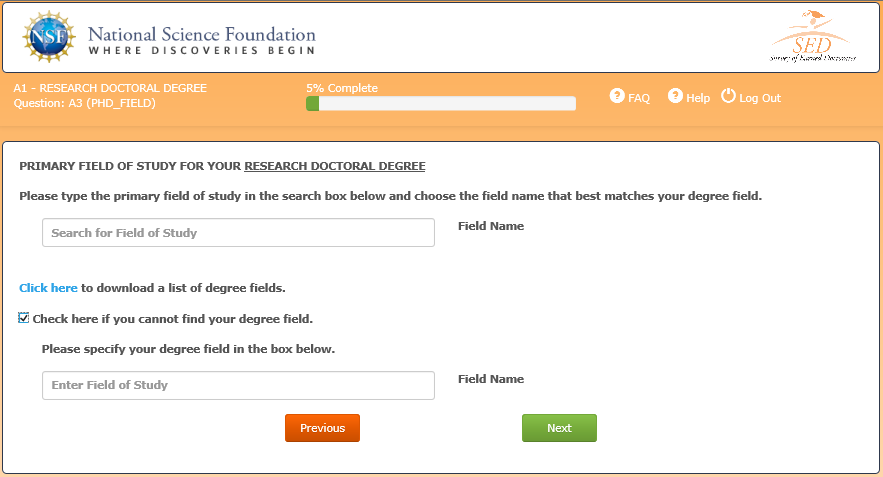
Dissertation Research Field of Study
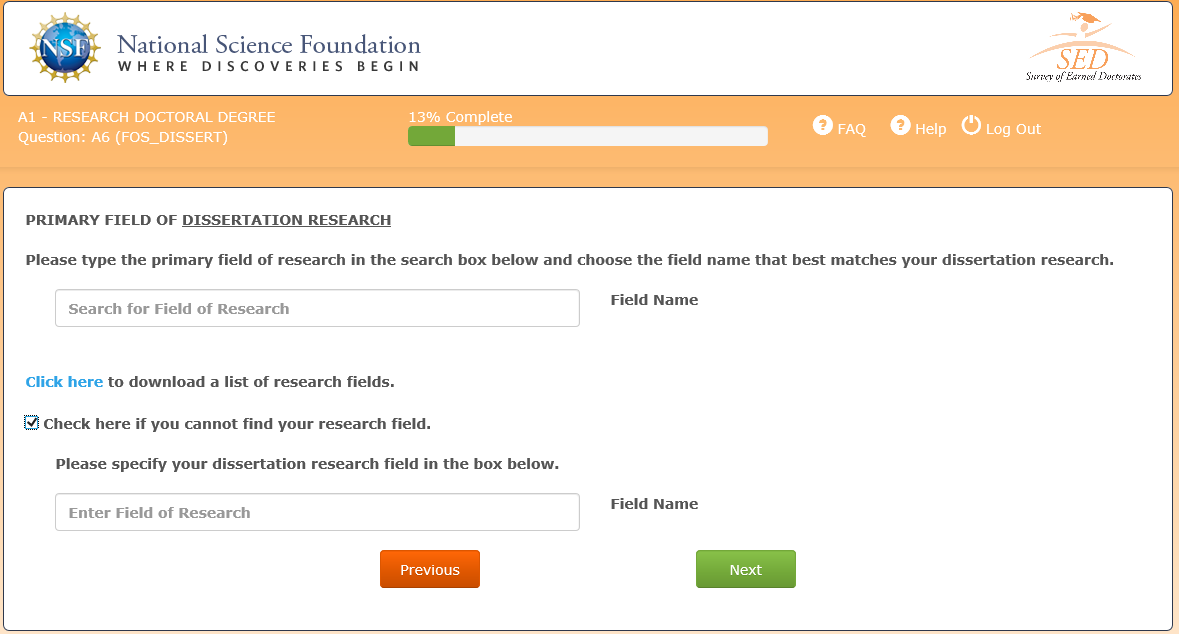
Other Postsecondary Degrees
Associate’s Degree Field of Study



Respondents answered questions about each degree reported. If “0” was entered for the question about how many associate’s degrees have been received, respondents were asked about their bachelor’s degrees followed by their master’s degrees.
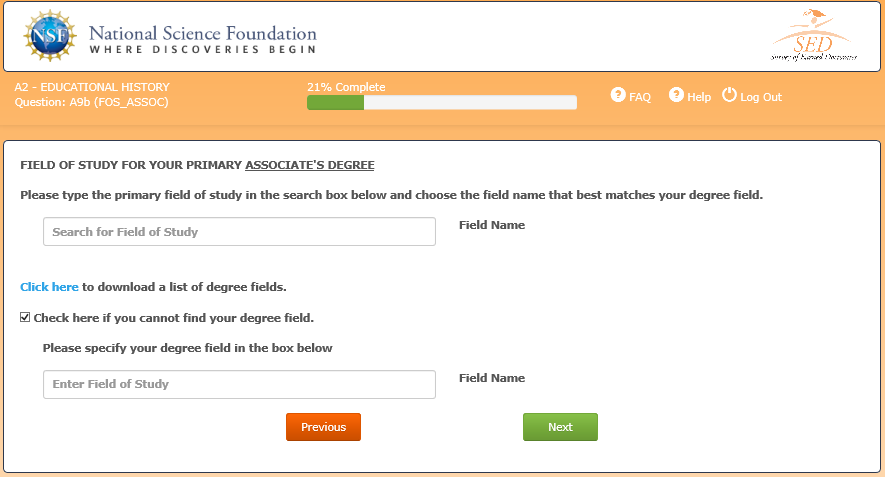
Bachelor’s Degree Field of Study


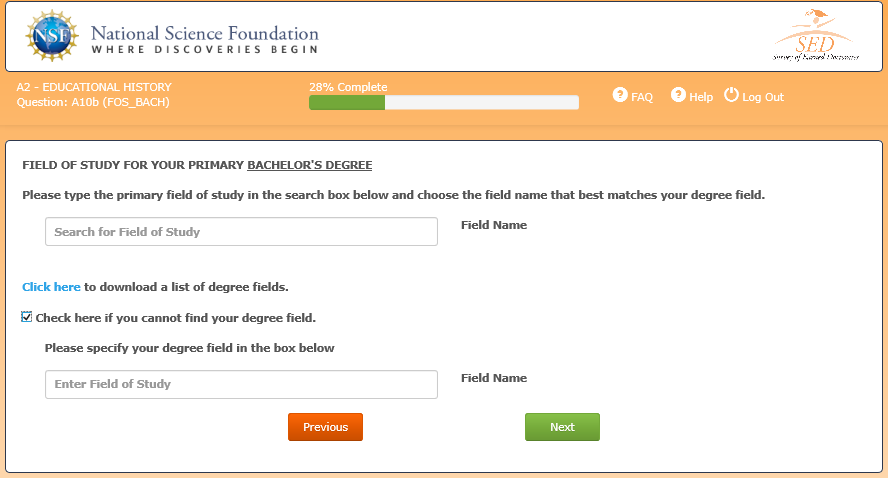
Master’s Degree Field of Study


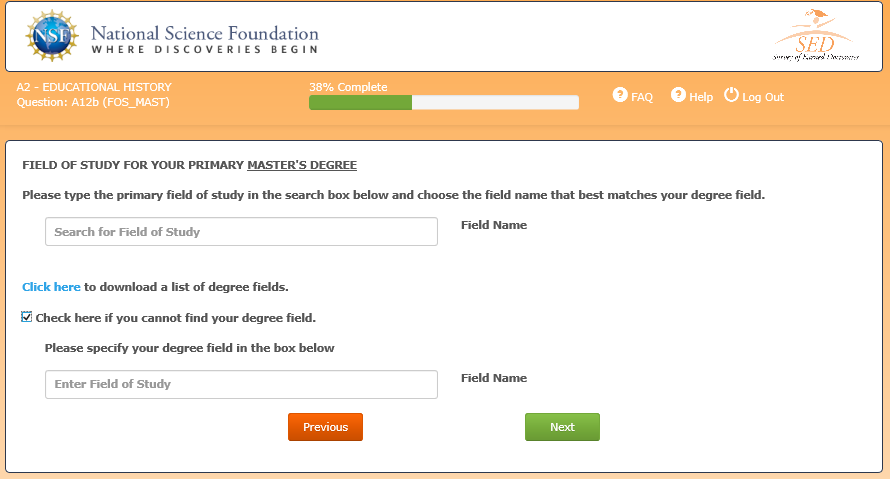
B.2 2021 Web Instrument Selected Screenshots
A PDF with 508-compliant versions of these field of study items are available on pages 2–8 of 2021 Survey of Earned Doctorates (questionnaire (https://www.nsf.gov/statistics/srvydoctorates/surveys/srvydoctorates-2021.pdf). The screenshots below show the items as web respondents saw them.
Research Doctoral Degree Field of Study

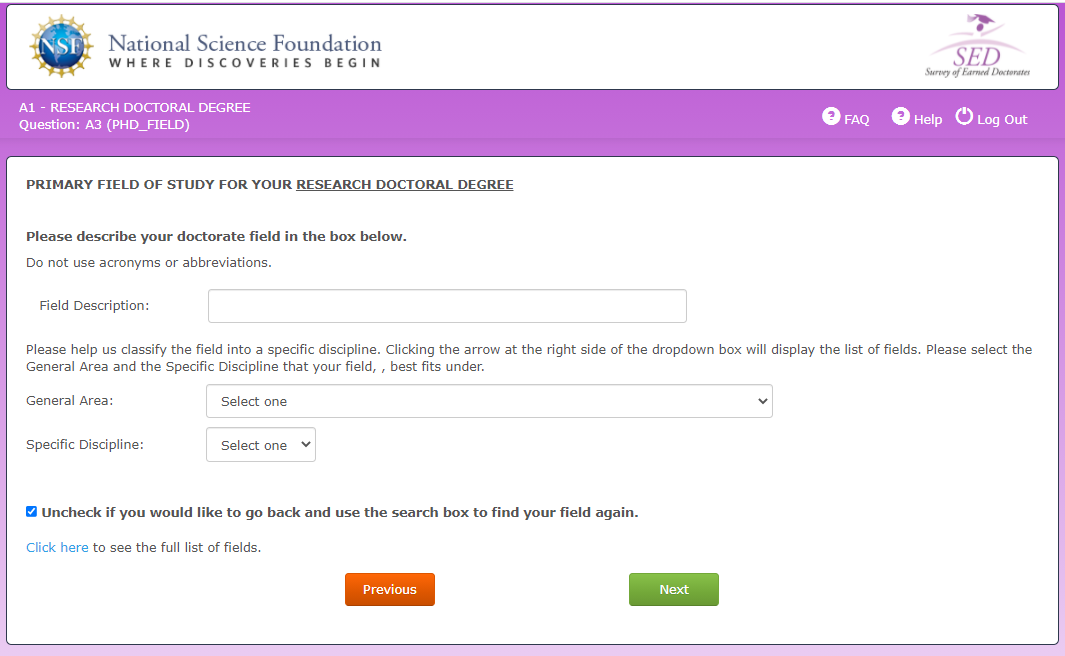
Dissertation Research Field of Study
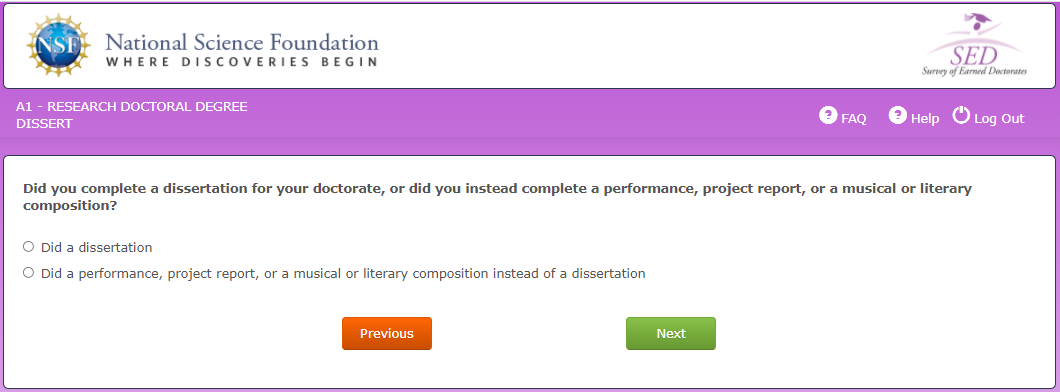


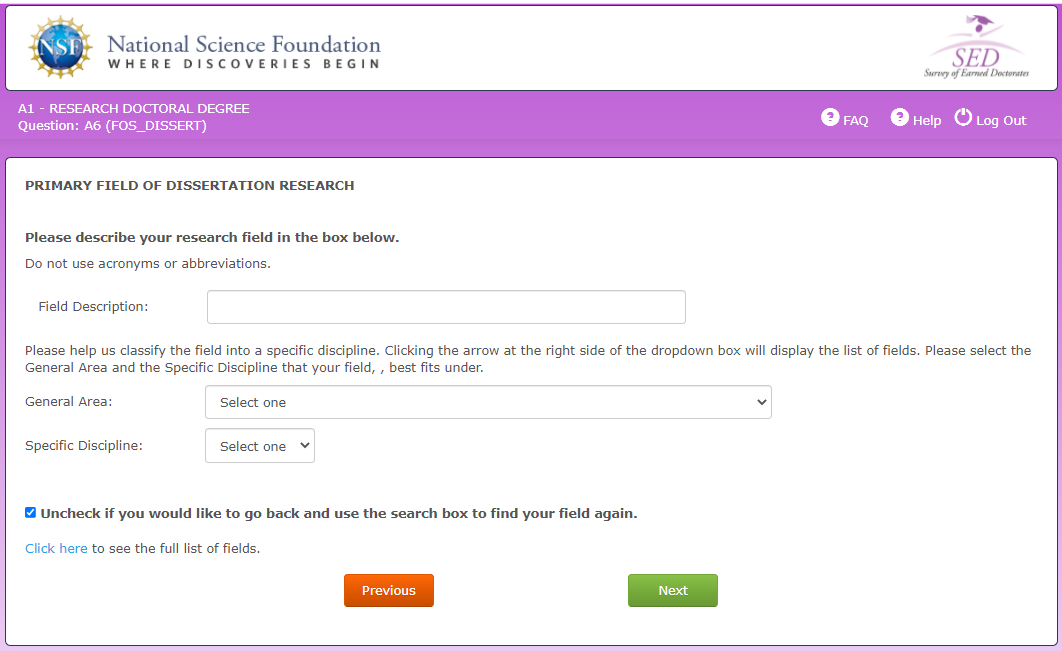
Other Postsecondary Degrees
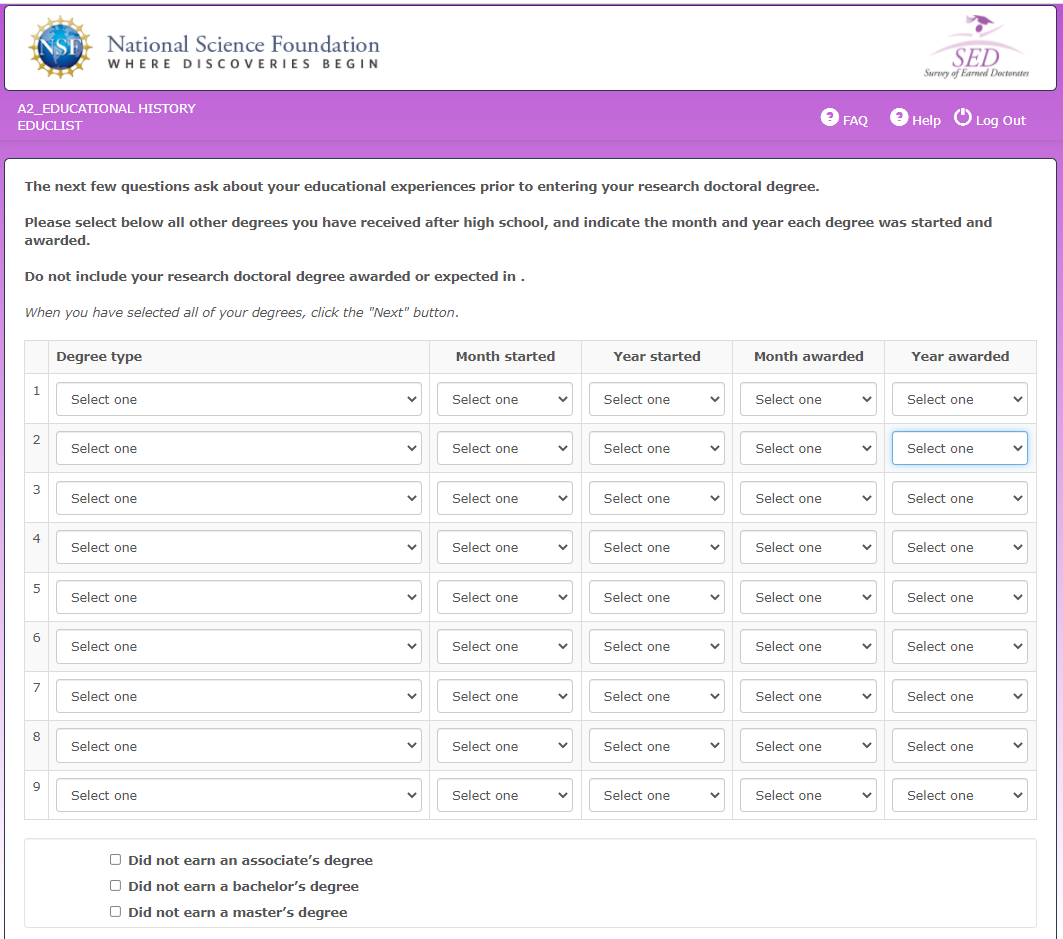
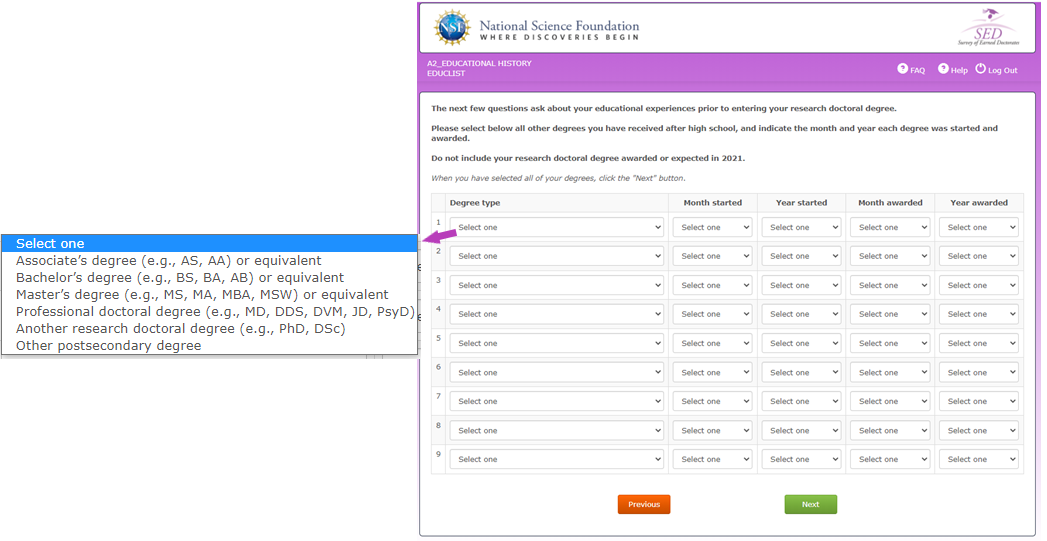
After selecting all postsecondary degrees earned, respondents were only shown questions pertaining to those degrees in the order they were reported. Additionally, if a respondent has two of same type of degree, they were shown those questions twice for each degree.
Associate’s Degree Field of Study
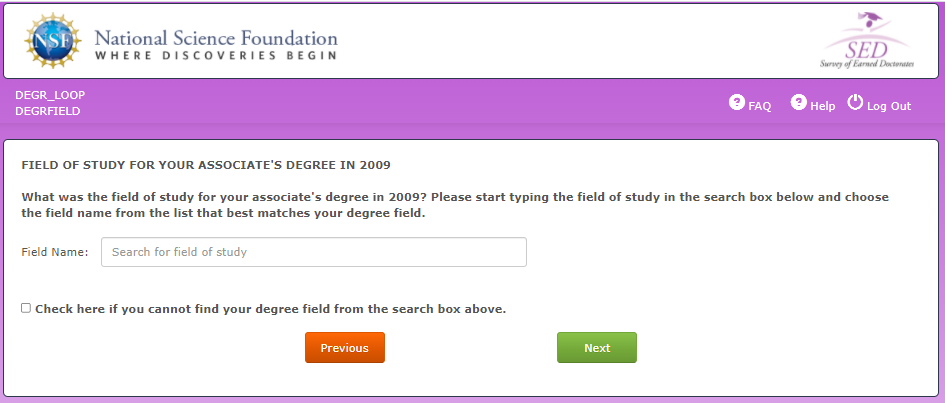

Bachelor’s Degree Field of Study
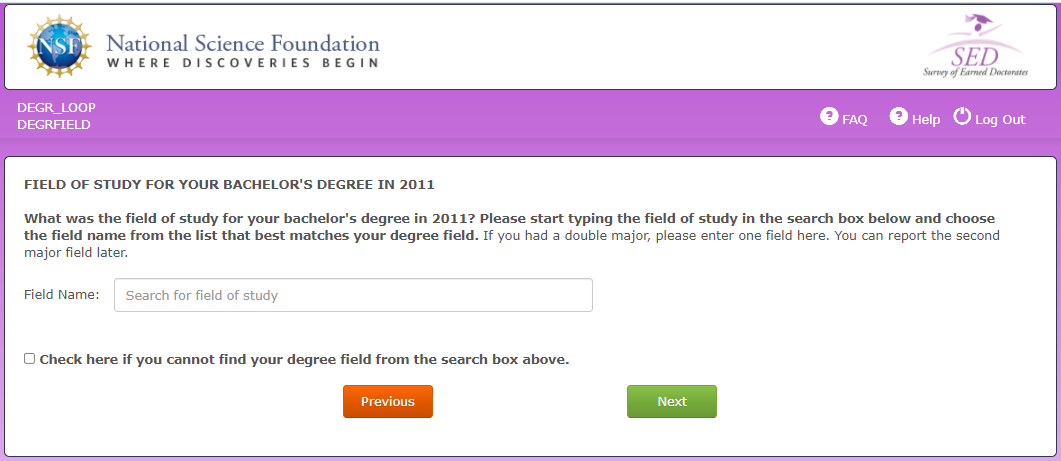
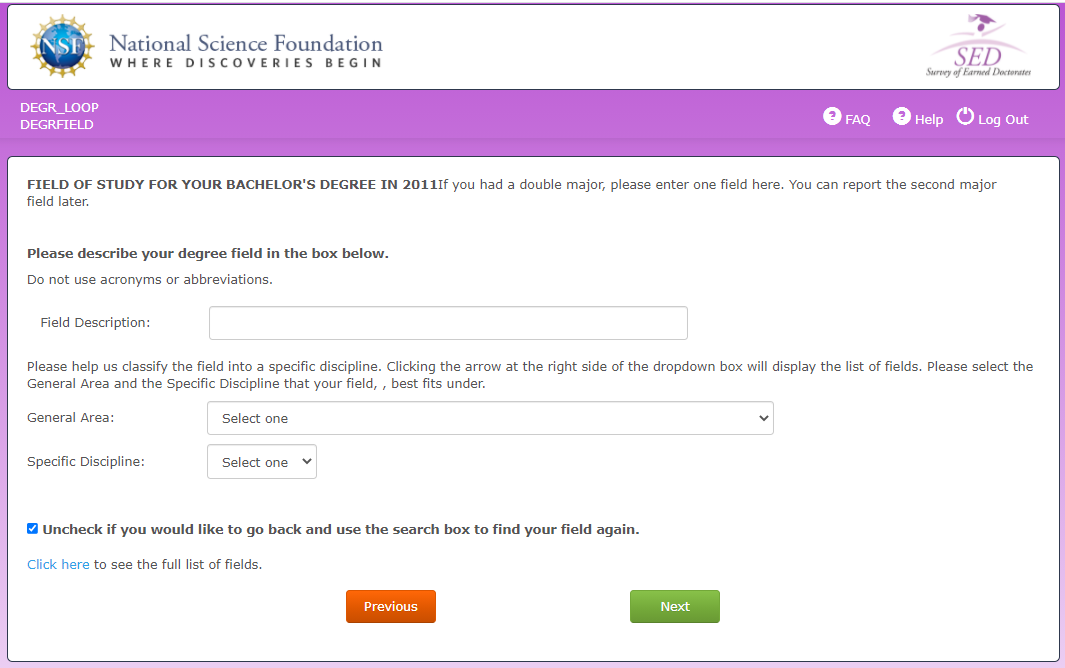
Master’s Degree Field of Study

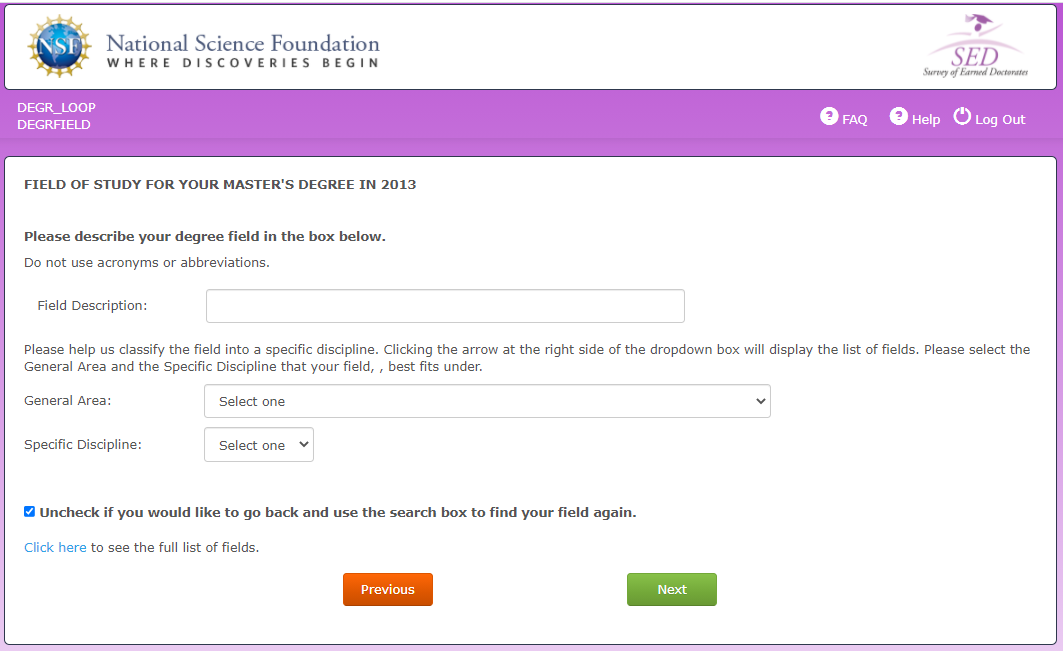
Appendix C. Field of Study Coding
The field of study (FOS) coding process for the 2021 Survey of Earned Doctorates (SED) using a modified version of the 2020 Classification of Instructional Programs (CIP) codes mirrors the previous years’ process when the SED historical FOS taxonomy was used. Respondents who do not self-code their FOS to one of the SED-CIP FOS codes in the Web instrument are asked to provide a FOS verbatim string for coding. For doctorates who do not self-code or provide a verbatim string, CIP codes or verbatim strings are generally provided by their doctoral institution.
The FOS coding is a two-step process: autocoding and manual coding. First, the FOS verbatim strings are sent through an autocoding program that assigns an SED-CIP code to verbatim strings. The autocoding process consists of:
- Verbatim string cleaning (e.g., remove symbols, apply consistent case formats)
- Direct matching of verbatim strings (and variants)
- Fuzzy matching of verbatim strings to SED-CIP labels
- Assigning SED-CIP codes to groups of FOS verbatim strings from respondents at the same institutions and
- Batch coding of verbatim strings
- Where strings that occur multiple times within the same SED year are only coded once and applied to all identical strings
For the 2021 SED, the autocoding program was updated to include the much larger number of SED-CIP verbatim strings. This resulted in 66% of respondent FOS verbatim strings being autocoded. In 2021, a slightly higher percentage of respondent FOS verbatim stings were autocoded for doctoral and associate’s degree fields than in 2020 (table C-1).
Autocoding rates for field of study verbatim strings: 2020 and 2021
CIP = Classification of Instructional Programs; FOS = field of study; SED = Survey of Earned Doctorates.
Source(s):
National Center for Science and Engineering Statistics, Survey of Earned Doctorates.
The strings that could not be autocoded were sent to manual coding. Manual coding refers to the process of SED coding staff manually reviewing uncoded respondent FOS verbatim strings to assign an SED-CIP code. Due to significantly higher rate of respondents self-coding their fields using the new SED-CIP taxonomy than the SED historical FOS taxonomy, the manual coding workload decreased in 2021 from 2020 (table C-2).
Manual coding of field of study verbatim strings: 2020 and 2021
CIP = Classification of Instructional Programs; FOS = field of study; SED = Survey of Earned Doctorates.
Source(s):
National Center for Science and Engineering Statistics, Survey of Earned Doctorates.
Appendix D. New and Historical Field of Study Items—Doctorate Records File (DRF) Documentation
|
AAFIELD |
Name: AAFIELD
Label: First associate’s degree field – historical SED-FOS code
Type: Numeric
Valid Years: FY 2017 – present
Question: N/A – Beginning in FY 2021, SED-FOS codes are no longer used.
Long Description: Prior to FY 2021, the three‑digit field codes on the Historical SED Field of Study (FOS) List were used to collect the field of first associate’s degree. Beginning in FY 2021, this data is based on a crosswalk from SED-CIP to SED-FOS codes.
Valid Values:
|
000–099 |
= |
Agriculture (Life Sciences) |
|
100–199 |
= |
Biological/ Biomedical Sciences (Life Sciences) |
|
200–299 |
= |
Health Sciences (Life Sciences) |
|
300–399 |
= |
Engineering |
|
400–419 |
= |
Computer and Information Sciences |
|
420–499 |
= |
Mathematics |
|
500–599 |
= |
Physical Sciences |
|
600–649 |
= |
Psychology |
|
650–699 |
= |
Social Sciences |
|
700–799 |
= |
Humanities |
|
800–899 |
= |
Education |
|
900–939 |
= |
Business Management/ Administration |
|
940–959 |
= |
Communication |
|
960–989 |
= |
Fields Not Elsewhere Classified |
|
998 |
= |
Logical skip (did not receive an associate's degree) |
|
999 |
= |
Unknown field |
|
Blank (.) |
= |
Unknown |
Notes: Beginning in FY 2021, a modified version of the 2020 Classification of Instructional Programs (CIP) codes was used to collect the field of study data. The historical SED-FOS codes were constructed using the SED-CIP code crosswalk (see DRF Codebook appendix G for more information). Therefore, the field data in FY 2021 may not be comparable to prior years. See table A-2 for a summary of SED-CIP codes in the new SED field taxonomy and table A-1 for a full list of SED-CIP codes in the new field taxonomy.
From FY 2017 to FY 2020, in addition to the first associate’s degree, up to two additional associate’s degree data were collected. Beginning in FY 2021, respondents are allowed to report up to 9 degrees total, which may include more than one associate’s degree. The first associate’s degree is determined based on the degree granting date. When AADEGRN=0, AAFIELD is set to 998.
|
AAFIELDCIP |
Name: AAFIELDCIP
Label: First associate’s degree field – SED-CIP code
Type: Numeric
Valid Years: FY 2021
Question: A14
Long Description: The six- to seven-digit field codes on the SED-CIP Field of Study List are used to collect the field of first associate’s degree.
Valid Values:
|
See the SED-CIP Field of Study List (see table A-1) |
||
|
99.9998 |
= |
Logical skip (did not receive an associate's degree) |
|
Blank (.) |
= |
Unknown |
Notes: Beginning in FY 2021, a modified version of the 2020 Classification of Instructional Programs (CIP) codes was used to collect the field of study data. Therefore, the field data in FY 2021 may not be comparable to prior years. See table A-2 for a summary of SED-CIP codes in the new SED field taxonomy and table A-1 for a full list of SED-CIP codes in the new field taxonomy (also see 2021 DRF Codebook appendix G for more details).
Also beginning in FY 2021, respondents are allowed to report up to 9 degrees total, which may include more than one associate’s degree. The first associate’s degree is determined based on the degree granting date. When AADEGRN=0, AAFIELD is set to 998.
|
BADBLFIELD |
Name: BADBLFIELD
Label: First baccalaureate double major field – historical SED-FOS code
Type: Numeric
Valid Years: FY 2017 – present
Question: NA – Beginning in FY 2021, SED-FOS codes are no longer used.
Long Description: Prior to FY 2021, the three‑digit field codes on the Historical SED Field of Study (FOS) List were used to collect the second major field of first baccalaureate. Beginning in FY 2021, this data is based on a crosswalk from SED-CIP to SED-FOS codes.
Valid Values:
|
000–099 |
= |
Agriculture (Life Sciences) |
|
100–199 |
= |
Biological/ Biomedical Sciences (Life Sciences) |
|
200–299 |
= |
Health Sciences (Life Sciences) |
|
300–399 |
= |
Engineering |
|
400–419 |
= |
Computer and Information Sciences |
|
420–499 |
= |
Mathematics |
|
500–599 |
= |
Physical Sciences |
|
600–649 |
= |
Psychology |
|
650–699 |
= |
Social Sciences |
|
700–799 |
= |
Humanities |
|
800–899 |
= |
Education |
|
900–939 |
= |
Business Management/ Administration |
|
940–959 |
= |
Communication |
|
960–989 |
= |
Fields Not Elsewhere Classified |
|
998 |
= |
Logical skip (did not receive a baccalaureate degree or did not have a double major) |
|
999 |
= |
Unknown field |
|
Blank (.) |
= |
Unknown |
Notes: Beginning in FY 2021, a modified version of the 2020 Classification of Instructional Programs (CIP) codes was used to collect the field of study data. The historical SED-FOS codes were constructed using the SED-CIP code crosswalk (see DRF Codebook appendix G). Therefore, the field data in FY 2021 may not be comparable to prior years. See table A-2 for a summary of SED-CIP codes in the new SED field taxonomy and table A-1 for a full list of SED-CIP codes in the new field taxonomy.
Also beginning in FY 2021, respondents were allowed to report up to 9 degrees total, which may include more than one baccalaureate. The first baccalaureate was determined based on the degree granting date. See BA2** variables for the most recent bachelor’s degree data, which are available for individuals who reported more than one bachelor’s degree.
Beginning FY 2017, respondents are asked whether they have completed a double major for their first bachelor’s degree. This second major was asked only for the first bachelor’s degree on the paper questionnaire whereas it was asked for each bachelor’s degree in the web survey instrument.
|
BADBLFIELDCIP |
Name: BADBLFIELDCIP
Label: First baccalaureate double major field – SED-CIP code
Type: Numeric
Valid Years: FY 2021
Question: A19
Long Description: The six- to seven-digit field codes on the SED-CIP Field of Study List are used to collect the second major field of first baccalaureate.
Valid Values:
|
See the SED-CIP Field of Study List (see table A-1). |
||
|
99.9998 |
= |
Logical skip (did not receive a baccalaureate degree or reported not having a double major) |
|
Blank (.) |
= |
Unknown |
Notes: Beginning in FY 2021, a modified version of the 2020 Classification of Instructional Programs (CIP) codes was used to collect the field of study data. Therefore, the field data in FY 2021 may not be comparable to prior years. See table A-2 for a summary of SED-CIP codes in the new SED field taxonomy and table A-1 for a full list of SED-CIP codes in the new field taxonomy (also see 2021 DRF Codebook appendix G for more details).
Also beginning in FY 2021, respondents were allowed to report up to 9 degrees total, which may include more than one baccalaureate. The first baccalaureate was determined based on the degree granting date. See BA2** variables for the most recent bachelor’s degree data, which are available for individuals who reported more than one bachelor’s degree.
Beginning FY 2017, respondents are asked whether they have completed a double major for their first bachelor’s degree. This second major was asked only for the first bachelor’s degree on the paper questionnaire whereas it was asked for each bachelor’s degree in the web survey instrument.
|
BAFIELD |
Name: BAFIELD
Label: First baccalaureate field – historical SED-FOS code
Type: Numeric
Valid Years: FY 1958 – present
Question: NA – Beginning in FY 2021, SED-FOS codes are no longer used.
Long Description: Prior to FY 2021, the three‑digit field codes on the Historical SED Field of Study (FOS) List were used to collect the field of the first baccalaureate. Beginning in FY 2021, this data is based on a crosswalk from SED-CIP to SED-FOS codes.
Valid Values:
|
000–099 |
= |
Agriculture (Life Sciences) |
|
100–199 |
= |
Biological/ Biomedical Sciences (Life Sciences) |
|
200–299 |
= |
Health Sciences (Life Sciences) |
|
300–399 |
= |
Engineering |
|
400–419 |
= |
Computer and Information Sciences |
|
420–499 |
= |
Mathematics |
|
500–599 |
= |
Physical Sciences |
|
600–649 |
= |
Psychology |
|
650–699 |
= |
Social Sciences |
|
700–799 |
= |
Humanities |
|
800–899 |
= |
Education |
|
900–939 |
= |
Business Management/ Administration |
|
940–959 |
= |
Communication |
|
960–989 |
= |
Fields Not Elsewhere Classified |
|
998 |
= |
Logical skip (did not receive a baccalaureate degree) (added in FY 2017) |
|
999 |
= |
Unknown field |
|
Blank (.) |
= |
Unknown |
Notes: Beginning in FY 2021, a modified version of the 2020 Classification of Instructional Programs (CIP) codes was used to collect the field of study data. The historical field data was coded using the SED-CIP to SED-FOS crosswalk (see DRF Codebook appendix G). Therefore, the 2021 data may not be comparable to prior survey cycle data.
From FY 2017 to FY 2020, in addition to the first bachelor’s degree, up to two additional bachelor’s degrees were collected. Beginning in FY 2021, respondents were allowed to report up to 9 degrees total, which may include more than one baccalaureate. The first baccalaureate was determined based on the degree granting date. See BA2** variables for the most recent bachelor’s degree data, which are available for individuals who reported more than one bachelor’s degree.
|
BAFIELDCIP |
Name: BAFIELDCIP
Label: First baccalaureate field – SED-CIP code
Type: Numeric
Valid Years: FY 2021
Question: A17
Long Description: The six- to seven-digit field codes on the SED-CIP Field of Study List are used to identify the field of first baccalaureate.
Valid Values:
|
See the SED-CIP Field of Study List (see table A-1). |
||
|
99.9998 |
= |
Logical skip (did not a baccalaureate degree) |
|
Blank (.) |
= |
Unknown |
Notes: Beginning in FY 2021, the SED modified Classification of Instructional Programs (CIP) codes are used to collect the degree fields. Therefore, the field of study data in FY 2021 may not be comparable to prior survey cycle data; see DRF Codebook appendix G for more information on the comparability of fields of study between 2021 and the prior years.
|
BA2FIELD |
Name: BA2FIELD
Label: Most recent baccalaureate field – historical SED-FOS code
Type: Numeric
Valid Years: FY 2017 – present
Question: NA – Beginning in FY 2021, SED-FOS codes are no longer used.
Long Description: Prior to FY 2021, the three‑digit field codes on the Historical SED Field of Study (FOS) List were used to collect the field of most recent baccalaureate. Beginning in FY 2021, this data is based on a crosswalk from SED-CIP to SED-FOS codes.
Valid Values:
|
000–099 |
= |
Agriculture (Life Sciences) |
|
100–199 |
= |
Biological/ Biomedical Sciences (Life Sciences) |
|
200–299 |
= |
Health Sciences (Life Sciences) |
|
300–399 |
= |
Engineering |
|
400–419 |
= |
Computer and Information Sciences |
|
420–499 |
= |
Mathematics |
|
500–599 |
= |
Physical Sciences |
|
600–649 |
= |
Psychology |
|
650–699 |
= |
Social Sciences |
|
700–799 |
= |
Humanities |
|
800–899 |
= |
Education |
|
900–939 |
= |
Business Management/ Administration |
|
940–959 |
= |
Communication |
|
960–989 |
= |
Fields Not Elsewhere Classified |
|
998 |
= |
Logical skip (did not receive more than one baccalaureate degree) |
|
Blank (.) |
= |
Unknown |
Notes: Beginning in FY 2021, a modified version of the 2020 Classification of Instructional Programs (CIP) codes was used to collect the field of study data. The historical field data was coded using the SED-CIP to SED-FOS crosswalk (see DRF Codebook appendix G). Therefore, the 2021 data may not be comparable to prior survey cycle data.
From FY 2017 to FY 2020, in addition to the first bachelor’s degree, up to two additional bachelor’s degree were collected. Beginning in FY 2021, respondents were allowed to report up to 9 degrees total, which may include more than one baccalaureate. The most recent bachelor’s degree data were determined based on the degree granting date; the data are only available for individuals reporting more than one bachelor’s degree.
|
BA2FIELDCIP |
Name: BA2FIELDCIP
Label: Most recent baccalaureate field – SED-CIP code
Type: Numeric
Valid Years: FY 2021
Question: A8
Long Description: The six- to seven-digit field codes on the SED-CIP Field of Study List are used to collect the field of most recent baccalaureate.
Valid Values:
|
See the SED-CIP Field of Study List (table A-1). |
||
|
99.9998 |
= |
Logical skip (did not more than one baccalaureate degree) |
|
Blank (.) |
= |
Unknown |
Notes: Beginning in FY 2021, a modified version of the 2020 Classification of Instructional Programs (CIP) codes was used to collect the field of study data. Therefore, the field data in FY 2021 may not be comparable to prior years. See table A-2 for a summary of SED-CIP codes in the new SED field taxonomy and table A-1 for a full list of SED-CIP codes in the new field taxonomy (also see 2021 DRF Codebook appendix G for more details).
Also beginning in FY 2021, respondents were allowed to report up to 9 degrees total, which may include more than one baccalaureate. The most recent bachelor’s degree data were determined based on the degree granting date; the data are only available for individuals reporting more than one bachelor’s degree.
|
MA1FIELD |
Name: MA1FIELD
Label: First master’s degree field – historical SED-FOS code
Type: Numeric
Valid Years: FY 2017 – present
Question: NA – Beginning in FY 2021, SED-FOS codes are no longer used.
Long Description: Prior to FY 2021, the three‑digit field codes on the Historical SED Field of Study (FOS) List were used to collect the field of the first master’s (e.g., MA, MS, MBA) or equivalent degree. Beginning in FY 2021, this data is based on a crosswalk from SED-CIP to SED-FOS codes.
Valid Values:
|
000–099 |
= |
Agriculture (Life Sciences) |
|
100–199 |
= |
Biological/ Biomedical Sciences (Life Sciences) |
|
200–299 |
= |
Health Sciences (Life Sciences) |
|
300–399 |
= |
Engineering |
|
400–419 |
= |
Computer and Information Sciences |
|
420–499 |
= |
Mathematics |
|
500–599 |
= |
Physical Sciences |
|
600–649 |
= |
Psychology |
|
650–699 |
= |
Social Sciences |
|
700–799 |
= |
Humanities |
|
800–899 |
= |
Education |
|
900–939 |
= |
Business Management/ Administration |
|
940–959 |
= |
Communication |
|
960–989 |
= |
Fields Not Elsewhere Classified |
|
998 |
= |
Logical skip (did not receive more than one master’s degree) |
|
Blank (.) |
= |
Unknown |
Notes: Beginning in FY 2021, a modified version of the 2020 Classification of Instructional Programs (CIP) codes was used to collect the field of study data. The historical field data was coded using the SED-CIP to SED-FOS crosswalk (see DRF Codebook appendix G). Therefore, the 2021 data may not be comparable to prior survey cycle data.
From FY 2017 to FY 2020, in addition to the most recent master’s degree, up to two additional master’s degrees were collected. Beginning in FY 2021, respondents were allowed to report up to 9 degrees total, which may include more than one master’s degree. The first master’s degree was determined based on the degree granting date and the data are only available for individuals reporting more than one master’s degree.
|
MA1FIELDCIP |
Name: MA1FIELDCIP
Label: First master’s degree field – SED-CIP code
Type: Numeric
Valid Years: FY 2021
Question: A22
Long Description: The six- to seven-digit field codes on the SED-CIP Field of Study List are used to collect the field of the first master’s (e.g., MA, MS, MBA) or equivalent degree.
Valid Values:
|
See the SED-CIP Field of Study List (table A-1). |
||
|
99.9998 |
= |
Logical skip (did not receive more than one master’s degree) |
|
Blank (.) |
= |
Unknown |
Notes: Beginning in FY 2021, a modified version of the 2020 Classification of Instructional Programs (CIP) codes was used to collect the field of study data. Therefore, the field data in FY 2021 may not be comparable to prior years. See table A-2 for a summary of SED-CIP codes in the new SED field taxonomy and table A-1 for a full list of SED-CIP codes in the new field taxonomy (also see 2021 DRF Codebook appendix G for more details).
Also beginning in FY 2021, respondents were allowed to report up to 9 degrees total, which may include more than one master’s degree. The first master’s degree was determined based on the degree granting date and the data are only available for individuals reporting more than one master’s degree.
|
MAFIELD |
Name: MAFIELD
Label: Most recent master’s degree field – historical SED-FOS code
Type: Numeric
Valid Years: FY 1958 – present
Question: NA – Beginning in FY 2021, SED-FOS codes are no longer used.
Long Description: Prior to FY 2021, the three‑digit field codes on the Historical SED Field of Study (FOS) List were used to collect the field of the most recent master’s (MA, MS, MBA) or equivalent degree. Beginning in FY 2021, this data is based on a crosswalk from SED-CIP to SED-FOS codes.
Valid Values:
|
000–099 |
= |
Agriculture (Life Sciences) |
|
100–199 |
= |
Biological/ Biomedical Sciences (Life Sciences) |
|
200–299 |
= |
Health Sciences (Life Sciences) |
|
300–399 |
= |
Engineering |
|
400–419 |
= |
Computer and Information Sciences |
|
420–499 |
= |
Mathematics |
|
500–599 |
= |
Physical Sciences |
|
600–649 |
= |
Psychology |
|
650–699 |
= |
Social Sciences |
|
700–799 |
= |
Humanities |
|
800–899 |
= |
Education |
|
900–939 |
= |
Business Management/ Administration |
|
940–959 |
= |
Communication |
|
960–989 |
= |
Fields Not Elsewhere Classified |
|
998 |
= |
Logical skip (did not receive a master’s degree) (added in FY 2017) |
|
Blank (.) |
= |
Unknown |
Notes: Beginning in FY 2021, a modified version of the 2020 Classification of Instructional Programs (CIP) codes was used to collect the field of study data. Therefore, the field data in FY 2021 may not be comparable to prior years. See table A-2 for a summary of SED-CIP codes in the new SED field taxonomy and table A-1 for a full list of SED-CIP codes in the new field taxonomy (also see 2021 DRF Codebook appendix G for more details).
Also beginning in FY 2021, respondents are allowed to report up to 9 degrees total, which may include more than one master’s degree. The most recent master’s degree was determined based on the degree granting date. See MA1** variables for the first master’s degree data, which are available for individuals who reported more than one master’s degree.
|
MAFIELDCIP |
Name: MAFIELDCIP
Label: Most recent master’s degree field – SED-CIP code
Type: Numeric
Valid Years: FY 2021
Question: A22
Long Description: Prior to FY 2021, the three‑digit field codes on the Historical SED Field of Study (FOS) List were used to collect the field of the most recent master’s (MA, MS, MBA) or equivalent degree. Beginning in FY 2021, this data is based on a crosswalk from SED-CIP to SED-FOS codes.
Valid Values:
|
See the SED-CIP Field of Study List (table A-1). |
||
|
99.9998 |
= |
Logical skip (did not receive a master’s degree) |
|
Blank (.) |
= |
Unknown |
Notes: Beginning in FY 2021, a modified version of the 2020 Classification of Instructional Programs (CIP) codes was used to collect the field of study data. Therefore, the field data in FY 2021 may not be comparable to prior years. See table A-2 for a summary of SED-CIP codes in the new SED field taxonomy and table A-1 for a full list of SED-CIP codes in the new field taxonomy (also see 2021 DRF Codebook appendix G for more details).
Also beginning in FY 2021, respondents are allowed to report up to 9 degrees total, which may include more than one master’s degree. The most recent master’s degree was determined based on the degree granting date. See MA1** variables for the first master’s degree data, which are available for individuals who reported more than one master’s degree.
|
PHDDISS |
Name: PHDDISS
Label: Primary dissertation field – historical SED-FOS code
Type: Numeric
Valid Years: FY 1988 – FY 1989, FY 1992 – present
Question: NA – Beginning in FY 2021, SED-FOS code is no longer used.
Long Description: Prior to FY 2021, the three‑digit field codes on the Historical SED Field of Study (FOS) List were used to collect the field of the primary field of doctoral dissertation. Beginning in FY 2021, this data is based on a crosswalk from SED-CIP to SED-FOS codes.
Valid Values:
|
000–099 |
= |
Agriculture (Life Sciences) |
|
100–199 |
= |
Biological/ Biomedical Sciences (Life Sciences) |
|
200–299 |
= |
Health Sciences (Life Sciences) |
|
300–399 |
= |
Engineering |
|
400–419 |
= |
Computer and Information Sciences |
|
420–499 |
= |
Mathematics |
|
500–599 |
= |
Physical Sciences |
|
600–649 |
= |
Psychology |
|
650–699 |
= |
Social Sciences |
|
700–799 |
= |
Humanities |
|
800–899 |
= |
Education |
|
900–939 |
= |
Business Management/ Administration |
|
940–959 |
= |
Communication |
|
960–989 |
= |
Fields Not Elsewhere Classified |
|
998 |
= |
Logical skip (dissertation not required; FY 1973 to FY 2003) |
|
Blank (.) |
= |
Unknown |
Notes: Beginning in FY 2021, a modified version of the 2020 Classification of Instructional Programs (CIP) codes was used to collect the field of study data. The historical field data was coded using the SED-CIP to SED-FOS crosswalk (see DRF Codebook appendix G). Therefore, the 2021 data may not be comparable to prior survey cycle data.
The field of dissertation may be different from the major field of doctorate (PHDFIELD).
|
PHDDISSCIP |
Name: PHDDISSCIP
Label: Primary dissertation field – SED-CIP code
Type: Numeric
Valid Years: FY 2021
Question: A5
Long Description: The six- to seven-digit field codes on the SED-CIP Field of Study List are used to collect the primary field of doctoral dissertation.
Valid Values:
|
See the SED-CIP Field of Study List (table A-1) |
||
|
Blank (.) |
= |
Unknown |
Notes: Beginning in FY 2021, a modified version of the 2020 Classification of Instructional Programs (CIP) codes was used to collect the field of study data. Therefore, the field data in FY 2021 may not be comparable to prior years. See table A-2 for a summary of SED-CIP codes in the new SED field taxonomy and table A-1 for a full list of SED-CIP codes in the new field taxonomy (also see 2021 DRF Codebook appendix G for more details).
The field of dissertation may be different from the major field of doctorate (PHDFIELD).
|
PHDDISS2 |
Name: PHDDISS2
Label: Secondary dissertation field – historical SED-FOS code
Type: Numeric
Valid Years: FY 2001 – present
Question: NA – Beginning in FY 2021, SED-FOS code is no longer used.
Long Description: Prior to FY 2021, the three‑digit field codes on the Historical SED Field of Study (FOS) List were used to collect the secondary field of doctoral dissertation research. Beginning in FY 2021, this data is based on a crosswalk from SED-CIP to SED-FOS codes.
Valid Values:
|
000–099 |
= |
Agriculture (Life Sciences) |
|
100–199 |
= |
Biological/ Biomedical Sciences (Life Sciences) |
|
200–299 |
= |
Health Sciences (Life Sciences) |
|
300–399 |
= |
Engineering |
|
400–419 |
= |
Computer and Information Sciences |
|
420–499 |
= |
Mathematics |
|
500–599 |
= |
Physical Sciences |
|
600–649 |
= |
Psychology |
|
650–699 |
= |
Social Sciences |
|
700–799 |
= |
Humanities |
|
800–899 |
= |
Education |
|
900–939 |
= |
Business Management/ Administration |
|
940–959 |
= |
Communication |
|
960–989 |
= |
Fields Not Elsewhere Classified |
|
998 |
= |
Logical skip (dissertation not interdisciplinary; added in FY 2017) |
|
Blank (.) |
= |
Unknown |
Notes: Beginning in FY 2021, a modified version of the 2020 Classification of Instructional Programs (CIP) codes was used to collect the field of study data. The historical field data was coded using the SED-CIP to SED-FOS crosswalk (see DRF Codebook appendix G). Therefore, the 2021 data may not be comparable to prior survey cycle data.
Beginning in FY 2017, PHDDISS2 was coded to 998 when the respondent reported that their dissertation was not interdisciplinary.
|
PHDDISS2CIP |
Name: PHDDISS2CIP
Label: Secondary dissertation field – SED-CIP code
Type: Numeric
Valid Years: FY 2021
Question: A5
Long Description: The six- to seven-digit field codes on the SED-CIP Field of Study List are used to identify the secondary field of doctoral dissertation research. The field of dissertation may be different from the major field of doctorate (PHDFIELD).
Valid Values:
|
See the SED-CIP Field of Study List (table A-1). |
||
|
99.9998 |
= |
Logical skip (Dissertation not interdisciplinary) |
|
Blank (.) |
= |
Unknown |
Notes: Beginning in FY 2021, the SED modified Classification of Instructional Programs (CIP) codes are used to collect the dissertation fields. Therefore, the data in FY 2021 may not be comparable to prior survey cycle data; see DRF Codebook appendix G for more information on the comparability of fields of study between 2021 and the prior years.
PHDDISS2CIP was coded to 998 when the respondent reported that their dissertation was not interdisciplinary.
|
PHDFIELD |
Name: PHDFIELD
Label: Doctorate field – historical SED-FOS code
Type: Numeric
Valid Years: FY 1920 – present
Question: NA – Beginning in FY 2021, SED-FOS code is no longer used.
Long Description: Prior to FY 2021, the three‑digit field codes on the Historical SED Field of Study (FOS) List were used to collect the field of doctoral degree. Beginning in FY 2021, this data is based on a crosswalk from SED-CIP to SED-FOS codes.
Valid Values:
|
000–099 |
= |
Agriculture (Life Sciences) |
|
100–199 |
= |
Biological/ Biomedical Sciences (Life Sciences) |
|
200–299 |
= |
Health Sciences (Life Sciences) |
|
300–399 |
= |
Engineering |
|
400–419 |
= |
Computer and Information Sciences |
|
420–499 |
= |
Mathematics |
|
500–599 |
= |
Physical Sciences |
|
600–649 |
= |
Psychology |
|
650–699 |
= |
Social Sciences |
|
700–799 |
= |
Humanities |
|
800–899 |
= |
Education |
|
900–939 |
= |
Business Management/ Administration |
|
940–959 |
= |
Communication |
|
960–989 |
= |
Fields Not Elsewhere Classified |
|
Blank (.) |
= |
Unknown |
Notes: Beginning in FY 2021, a modified version of the 2020 Classification of Instructional Programs (CIP) codes was used to collect the field of study data. The historical field data was coded using the SED-CIP to SED-FOS crosswalk (see DRF Codebook appendix G). Therefore, the 2021 data may not be comparable to prior survey cycle data.
In recent years, the SED has not been able to establish PHDFIELD for a small number of records. These records receive a code of 999 (for “Unknown field”).
|
PHDFIELDCIP |
Name: PHDFIELDCIP
Label: Doctorate field – SED-CIP code
Type: Numeric
Valid Years: FY 2021
Question: A3
Long Description: The six- to seven-digit field codes on the SED-CIP Field of Study List are used to collect the field of doctoral degree.
Valid Values:
|
See the SED-CIP Field of Study List (table A-1) |
Notes: Beginning in FY 2021, a modified version of the 2020 Classification of Instructional Programs (CIP) codes was used to collect the field of study data. Therefore, the field data in FY 2021 may not be comparable to prior years. See table A-2 for a summary of SED-CIP codes in the new SED field taxonomy and table A-1 for a full list of SED-CIP codes in the new field taxonomy (also see 2021 DRF Codebook appendix G for more details).
|
PHDFLDBRD |
Name: PHDFLDBRD
Label: Historical Broad field of doctorate (recode) – historical SED-FOS code
Type: Numeric
Valid Years: FY 1920–present
Question: NA – Recoded from PHDFIELD.
Long Description: This variable is a recode of PHDFIELD.
Valid Values:
|
1 |
= |
Life Sciences |
|
2 |
= |
Physical sciences and earth sciences |
|
3 |
= |
Mathematics and computer sciences |
|
4 |
= |
Psychology and social sciences |
|
5 |
= |
Engineering |
|
6 |
= |
Education |
|
7 |
= |
Humanities and arts |
|
8 |
= |
Other |
Notes: This data is a recode of the PHDFIELD variable (see DRF Codebook appendix G for field aggregations). Therefore, the field data in FY 2021 may not be comparable to prior years.
|
PHDFLDBRDCIP |
Name: PHDFLDBRDCIP
Label: Broad field of doctorate (recode) – SED-CIP code
Type: Numeric
Valid Years: FY 2021
Question: NA – Recoded from PHDFIELDCIP
Long Description: This variable is a recode of PHDFIELDCIP
Valid Values:
|
11 |
= |
Agricultural sciences and natural resources |
|
12 |
= |
Biological and biomedical sciences |
|
20 |
= |
Computer and information sciences |
|
21 |
= |
Engineering |
|
24 |
= |
Geosciences, atmospheric, and ocean sciences |
|
27 |
= |
Health sciences |
|
30 |
= |
Mathematics and statistics |
|
35 |
= |
Multidisciplinary/ interdisciplinary sciences |
|
37 |
= |
Physical sciences |
|
40 |
= |
Psychology |
|
44 |
= |
Social sciences |
|
50 |
= |
Business |
|
60 |
= |
Education |
|
70 |
= |
Humanities |
|
80 |
= |
Visual and performing arts |
|
90 |
= |
Other non-science and engineering |
Notes: This data is a recode of PHDFIELDCIP (see table A-1 for field aggregations).
|
PHDFLDMAJ |
Name: PHDFLDMAJ
Label: Historical major field of doctorate (recode) – historical SED-FOS code
Type: Numeric
Valid Years: FY 1920 – present
Question: NA – Recoded from PHDFIELD.
Long Description: This variable is a recode of PHDFIELD.
Valid Values:
|
1 |
= |
Agricultural sciences and natural resources |
|
2 |
= |
Biological and biomedical sciences |
|
3 |
= |
Health sciences |
|
4 |
= |
Chemistry |
|
5 |
= |
Geosciences, atmospheric, and ocean sciences |
|
6 |
= |
Physics and astronomy |
|
7 |
= |
Computer and information sciences |
|
8 |
= |
Mathematics and statistics |
|
9 |
= |
Psychology |
|
10 |
= |
Anthropology |
|
11 |
= |
Economics |
|
12 |
= |
Political Science and government |
|
13 |
= |
Sociology |
|
14 |
= |
Other social sciences |
|
15 |
= |
Aerospace, aeronautical, and astronautical engineering |
|
16 |
= |
Bioengineering and biomedical engineering |
|
17 |
= |
Chemical engineering |
|
18 |
= |
Civil engineering |
|
19 |
= |
Electrical, electronics, and communications engineering |
|
20 |
= |
Industrial and manufacturing engineering |
|
21 |
= |
Materials science engineering |
|
22 |
= |
Mechanical engineering |
|
23 |
= |
Other engineering |
|
24 |
= |
Education administration |
|
25 |
= |
Education research |
|
26 |
= |
Teacher education |
|
27 |
= |
Teaching fields |
|
28 |
= |
Other education |
|
29 |
= |
Foreign languages and literature |
|
30 |
= |
History |
|
31 |
= |
Letters |
|
32 |
= |
Other humanities and arts |
|
33 |
= |
Business |
|
34 |
= |
Communication |
|
35 |
= |
Non-S&E fields nec |
|
99 |
= |
Unknown field |
Notes: This data is a recode of the PHDFIELD variable (see DRF Codebook appendix G for field aggregations). Therefore, the field data in FY 2021 may not be comparable to prior years.
|
PHDFLDMAJCIP |
Name: PHDFLDMAJCIP
Label: Major field of doctorate – SED-CIP code
Type: Numeric
Valid Years: FY 2021
Question: NA – Recoded from PHDFIELDCIP
Long Description: This variable is a recode of PHDFIELDCIP
Valid Values:
|
1110 |
= |
Agricultural, animal, plant, and veterinary sciences |
|
1125 |
= |
Natural resources and conservation |
|
1210 |
= |
Biochemistry, biophysics, and molecular biology |
|
1212 |
= |
Bioinformatics, biostatistics, and computational biology |
|
1220 |
= |
Cell/ cellular biology and anatomy |
|
1222 |
= |
Ecology, evolutionary biology, and epidemiology |
|
1224 |
= |
Genetics and genomics |
|
1226 |
= |
Microbiology and immunology |
|
1228 |
= |
Neurobiology and neurosciences |
|
1230 |
= |
Pharmacology and toxicology |
|
1232 |
= |
Physiology, oncology, and cancer biology |
|
1290 |
= |
Biological and biomedical sciences, other |
|
2010 |
= |
Computer science |
|
2090 |
= |
Computer and information sciences, other |
|
2110 |
= |
Biological, biomedical, and biosystems engineering |
|
2115 |
= |
Chemical and petroleum engineering |
|
2117 |
= |
Civil, environmental, and transportation engineering |
|
2124 |
= |
Electrical and computer engineering |
|
2139 |
= |
Engineering technologies |
|
2147 |
= |
Industrial engineering and operations research |
|
2150 |
= |
Materials and mining engineering |
|
2153 |
= |
Mechanical engineering |
|
2190 |
= |
Engineering, other |
|
2420 |
= |
Geological and earth sciences |
|
2450 |
= |
Ocean/ marine sciences and atmospheric science |
|
2725 |
= |
Nursing and nursing science |
|
2730 |
= |
Pharmacy and pharmaceutical sciences |
|
2735 |
= |
Public health |
|
2790 |
= |
Health sciences, other |
|
3010 |
= |
Applied mathematics |
|
3015 |
= |
Mathematics |
|
3020 |
= |
Statistics |
|
3520 |
= |
Interdisciplinary computer sciences |
|
3590 |
= |
Multidisciplinary/ interdisciplinary sciences, other |
|
3710 |
= |
Astronomy and astrophysics |
|
3720 |
= |
Chemistry |
|
3730 |
= |
Materials sciences |
|
3740 |
= |
Physics |
|
4010 |
= |
Clinical psychology |
|
4020 |
= |
Counseling and applied psychology |
|
4040 |
= |
Research and experimental psychology |
|
4090 |
= |
Psychology, other |
|
4410 |
= |
Anthropology |
|
4420 |
= |
Area, ethnic, cultural, and group studies |
|
4430 |
= |
Economics |
|
4450 |
= |
Political science and government |
|
4460 |
= |
Public policy analysis |
|
4480 |
= |
Sociology, demography, and population studies |
|
4490 |
= |
Social sciences, other |
|
5010 |
= |
Business administration and management |
|
5090 |
= |
Business, other |
|
6015 |
= |
Education leadership and administration |
|
6020 |
= |
Education research |
|
6050 |
= |
Teacher education |
|
6090 |
= |
Education, other |
|
7020 |
= |
English language and literature, letters |
|
7030 |
= |
Foreign languages, literatures, and linguistics |
|
7040 |
= |
History |
|
7060 |
= |
Philosophy and religious studies |
|
7090 |
= |
Humanities, other |
|
8050 |
= |
Performing arts |
|
8070 |
= |
Visual arts, media studies, and design |
|
9020 |
= |
Communications and journalism |
|
9040 |
= |
Multidisciplinary/ interdisciplinary studies |
|
9060 |
= |
Public administration and social services |
|
9090 |
= |
Non-science and engineering, other |
Notes: This data is a recode of PHDFIELDCIP (see table A-1 for field aggregations).
|
PHDFLDDETCIP |
Name: PHDFLDDETCIP
Label: Detailed field of doctorate – SED-CIP code
Type: Numeric
Valid Years: FY 2021
Question: NA – Recoded from PHDFIELDCIP
Long Description: This variable is a recode of PHDFIELDCIP
Valid Values:
|
See the SED-CIP Detailed Fields (see table A-1). |
Notes: This data is a recode of PHDFIELDCIP (see table A-1 for field aggregations).
Suggested Citation
Contact Us
NCSES
Directorate for Social, Behavioral and Economic Sciences
National Science Foundation
2415 Eisenhower Avenue, Suite W14200
Alexandria, VA 22314
Tel: (703) 292-8780
FIRS: (800) 877-8339
TDD: (800) 281-8749
E-mail: ncsesweb@nsf.gov
 An official website of the United States government
An official website of the United States government


